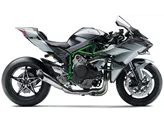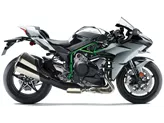Kawasaki Ninja H2 2015 vs. Yamaha R1 2015

Kawasaki Ninja H2 2015

Yamaha R1 2015
Visão geral - Kawasaki Ninja H2 2015 vs Yamaha R1 2015
The Kawasaki Ninja H2 2015 and the Yamaha R1 2015 are both high-performance supersport motorcycles that offer impressive power and performance.
In terms of engine specifications, the Kawasaki Ninja H2 has a bore of 76 mm and a stroke of 55 mm, while the Yamaha R1 has a bore of 79 mm and a stroke of 50.9 mm. Both motorcycles have a displacement of 998cc and produce 200 horsepower. However, the Kawasaki Ninja H2 has a higher torque of 133.5 Nm compared to the Yamaha R1's torque of 112.4 Nm. The Kawasaki Ninja H2 also has a lower compression ratio of 8.5, while the Yamaha R1 has a higher compression ratio of 13.
In terms of suspension, both motorcycles feature telescopic forks at the front. However, the Yamaha R1 has a unique upside-down telescopic fork, which provides better stability and handling.
When it comes to the chassis, the Kawasaki Ninja H2 has a steel frame, while the Yamaha R1 has an aluminum frame. The Yamaha R1's Deltabox frame is known for its rigidity and lightweight construction, which contributes to better handling and maneuverability.

Kawasaki Ninja H2 2015
Both motorcycles have dual disc brakes at the front, providing excellent stopping power.
In terms of dimensions, the Kawasaki Ninja H2 has a wider front tire of 120 mm compared to the Yamaha R1's 120 mm front tire. The Kawasaki Ninja H2 also has a wider rear tire of 200 mm compared to the Yamaha R1's 190 mm rear tire. The Kawasaki Ninja H2 has a longer wheelbase of 1455 mm compared to the Yamaha R1's 1405 mm wheelbase. The seat height of the Kawasaki Ninja H2 is 825 mm, while the Yamaha R1 has a higher seat height of 855 mm.
In terms of weight, the Kawasaki Ninja H2 weighs 238 kg (with ABS), while the Yamaha R1 weighs 199 kg (with ABS).
Both motorcycles have a fuel tank capacity of 17 liters.
In terms of strengths, the Kawasaki Ninja H2 is praised for its excellent build quality, fascinating turbocharged engine, and impressive traction, acceleration, and speed. The narrow seat provides a secure position for riders of all sizes, and the motorcycle offers great stability and inspires confidence despite its high performance. The Kawasaki Ninja H2 also has strong brakes and high-quality details.

Yamaha R1 2015
The Yamaha R1 is praised for its amazing sound, strong peak revs, and a great racing feel on the saddle. It also offers a superior electronic package and high-quality finishing.
However, the Kawasaki Ninja H2 has some weaknesses, including a less responsive behavior in the transition from push mode to acceleration phase and understeer in fast corners. It may also be challenging for riders taller than 185 cm to fit their feet into the overall aerodynamic concept.
The Yamaha R1 has weaknesses such as torque sag in the middle and stability issues during braking.
In conclusion, both the Kawasaki Ninja H2 2015 and the Yamaha R1 2015 are powerful and high-performance motorcycles with their own strengths and weaknesses. The Kawasaki Ninja H2 offers a unique turbocharged engine and excellent build quality, while the Yamaha R1 provides an exhilarating sound and a racing feel. Riders should consider their preferences and riding style when choosing between these two models.
Especificações técnicas Kawasaki Ninja H2 2015 em comparação com Yamaha R1 2015
Prós e contras em comparação
Prós e contras em comparação
Kawasaki Ninja H2 2015

A Ninja H2 representa um marco na história das motos. Não só está repleta de inovações electrónicas, como também oferece tecnologias completamente novas em termos de construção e mecânica do motor. Este objeto de investigação de alta tecnologia de uma empresa tecnológica japonesa está atualmente à venda e também pode ser conduzido. Basicamente, anda como uma mota normal, mas com muito mais potência. No início, a resposta do motor é um desafio, mas os fanáticos por velocidade encontrarão uma forma de conduzir e desfrutar desta fascinante mota.
Yamaha R1 2015

A nova R1 é um grande sucesso e já não se compara ao modelo anterior. Esta era considerada uma boa mota de estrada rural e era necessário fazer grandes investimentos para as excursões às pistas de corrida. Agora é o contrário. A nova R1 foi desenvolvida com um claro enfoque na pista de corrida. O pacote eletrónico parece extraordinário, os fanáticos por tecnologia terão o que merecem. Os fãs da Yamaha têm de a comprar, finalmente têm uma mota digna. A R1 tem ligeiras fraquezas na travagem - torna-se um pouco instável. Se quiser comprar uma moto de competição pronta a usar, sem ter de trabalhar no chassis, é melhor optar pela R1M. A suspensão eletrónica Öhlins funciona perfeitamente e não tem pontos fracos. Para uma utilização pura em pista, o segundo ponto fraco da R1 pode ser facilmente resolvido. O buraco de binário no meio pode ser facilmente eliminado com um novo mapeamento.
Comparação de preços Preço médio de mercado Kawasaki Ninja H2 vs Yamaha R1
There are a few key differences between a Kawasaki Ninja H2 2015 and a Yamaha R1 2015. There are the same number of bikes of both models available on the 1000PS.de marketplace, specifically 4. It takes less time to sell a Yamaha R1 with 76 days compared to 153 days for the Kawasaki Ninja H2. Since model year 2015 1000PS.de editors have written 27 reviews for the Kawasaki Ninja H2 and 80 reviews for the Yamaha R1 since model year 2005. The first review for the Kawasaki Ninja H2 was published on 31/08/2014 and now has more than 5.600 views. This compares to more than 3.900 views for the first review on Yamaha R1 published on 28/04/2003.





















